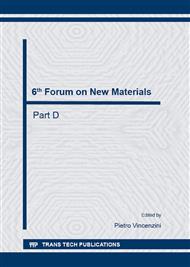[1]
R. Elfrink, T. M. Kamel, M. Goedbloed, S. Matova, D. Hohlfeld, Y. Van Andel, R. Van Schaijk, Vibration energy harvesting with aluminum nitride-based piezoelectric devices, Journal of Micromechanics and Microengineering (2011), p.095004.
DOI: 10.1088/0960-1317/19/9/094005
Google Scholar
[2]
R. Elfrink, M. Renaud, T. Kamel, C. De Nooijer, M. Jambunathan, et al, Vacuum-packaged piezoelectric vibration energy harvesters: damping contributions and autonomy for a wireless sensor system, Journal of Micromechanics and Microengineering Vol. 20 No. 10 (2010).
DOI: 10.1088/0960-1317/20/10/104001
Google Scholar
[3]
H. A. C. Tilmans, Equivalent circuit representation of electromechanical transducers: I. Lumped-parameter systems, Journal of Micromechanics and Microengineering Vol. 6 (1996), pp.157-176.
DOI: 10.1088/0960-1317/6/1/036
Google Scholar
[4]
M. Renaud, P. Fiorini, C. Van Hoof, Optimization of a piezoelectric unimorph for shock and impact energy harvesting, Smart Material and Strucures Vol. 16 (2007), pp.1125-1135.
DOI: 10.1088/0964-1726/16/4/022
Google Scholar
[5]
M. Renaud, R. Elfrink, M. Jambunathan, C. de Nooijer, Z. Wang, M. Rovers, R. Vullers, R. van Schaijk, Optimum power and efficiency of piezoelectric vibration energy harvesters with sinusoidal and random vibrations, Journal of Micromechanics and Microengineering Vol. 22 No. 10 (2012).
DOI: 10.1088/0960-1317/22/10/105030
Google Scholar
[6]
M. Renaud, Piezoelectric energy harvesters for wireless sensor networks, PhD thesis Katholieke Universiteit Leuven.
Google Scholar
[7]
Y. C. Shu, I. C. Lien, Efficiency of energy conversion for a piezoelectric power harvesting system, Journal of Micromechanics and Microengineering Vol. 16 (2006), pp.2429-2438.
DOI: 10.1088/0960-1317/16/11/026
Google Scholar
[8]
E. Lefeuvre, A. Badel, C. Richard, L. Petit, D. Guyomar, A comparison between several vibration-powered piezoelectric generators for standalone systems, Sensors and Actuators Vol. 126 No. 2 (2006), pp.405-416.
DOI: 10.1016/j.sna.2005.10.043
Google Scholar
[9]
Y. K. Ramadass, A. P. Chandrakasan, An efficient piezoelectric energy-harvesting interface circuit using a bias-flip rectifier and shared inductor, IEEE ISSCC (2009), pp.296-297.
DOI: 10.1109/isscc.2009.4977425
Google Scholar
[10]
Y. K. Ramadass, A. P. Chandrakasan, An efficient piezoelectric energy-harvesting interface circuit using a bias-flip rectifier and shared inductor, IEEE JSSC Vol. 45 (2009), pp.189-204.
DOI: 10.1109/isscc.2009.4977425
Google Scholar
[11]
E. Dallago, D. Miatton, G. Venchi, V. Bottarel, G. Frattini, G. Ricotti, M. Schipani, Active self supplied AC-DC converter for piezoelectric energy scavenging systems with supply independent bias, IEEE ISCAS (2008), pp.1448-1451.
DOI: 10.1109/iscas.2008.4541701
Google Scholar
[12]
C. van Liempd, S. Stanzione, Y. Allasasmeh, C. Van Hoof, A 1µW-to-1mW energy-aware interface IC for piezoelectric harvesting with 40nA quiescent current and zero-bias active rectifiers, IEEE ISSCC (2013), pp.76-77.
DOI: 10.1109/isscc.2013.6487644
Google Scholar
[13]
M. Shim, J. Kim, J. Jung, C. Kim, Self-powered 30µW-to-10mW piezoelectric energy-harvesting system with 9. 09ms/V Maximum Power Point Tracking time, IEEE ISSCC (2014), pp.406-407.
DOI: 10.1109/isscc.2014.6757490
Google Scholar
[14]
E. O Torres, G. A. Rincón-Mora, A 0. 7-µm BiCMOS Electrostatic energy-harvesting system IC, IEEE JSSC Vol. 45 No. 2 (2010), pp.483-496.
DOI: 10.1109/jssc.2009.2038431
Google Scholar
[15]
E. O. Torres, G. A. Rincón-Mora, Electrostatic energy-harvesting and battery-charging CMOS system prototype, IEEE Transactions on Circuits and Systems Vol. 56 No. 9 (2009), p.1938-(1948).
DOI: 10.1109/tcsi.2008.2011578
Google Scholar
[16]
S. Stanzione, C. van Liempd, C. Van Hoof, Electronics Letters Vol. 49 No. 3 (2013), pp.210-211.
Google Scholar
[17]
S. Stanzione, C. van Liempd, R. van Schaijk, R. Y. Naito, R. F. Yazicioglu, C. Van Hoof, A self-biased 5-to-60V input voltage and 25-to-1600µW integrated DC-DC buck converter with fully analog MPPT algorithm reaching up to 88% end-to-end efficiency, IEEE ISSCC(2013).
DOI: 10.1109/isscc.2013.6487643
Google Scholar
[18]
S. Stanzione, C. van Liempd, R. van Schaijk, R. Y Naito, R. F. Yazicioglu, C. Van Hoof, A high voltage self-biased integrated DC-DC buck converter with fully analog MPPT algorithm for electrostatic energy harvesters, IEEE JSSC Vol. 48 No. 12 (2013).
DOI: 10.1109/jssc.2013.2283152
Google Scholar
[19]
R. Elfrink, V. van Acht, S. Stanzione, P. Bembnowicz, M. Tutelaers, R. van Schaijk, Fully autonomous tire pressure monitoring systems (TPMS) powered by a vibrational electrostatic energy harvester, Smart System Integration (2014), pp.69-76.
Google Scholar


